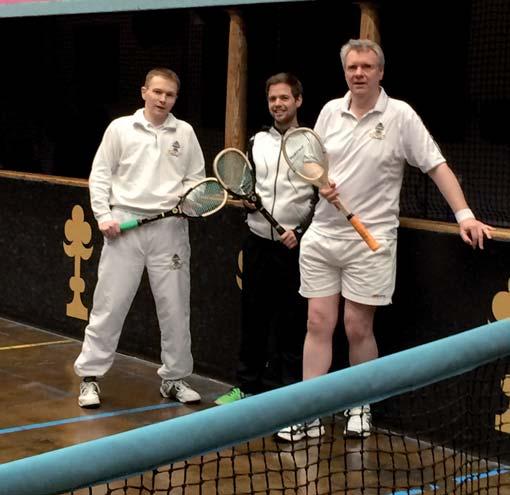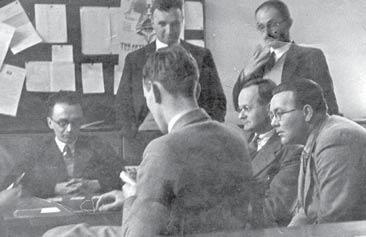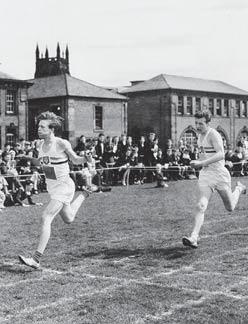
5 minute read
The Oldest New Sport
from ONA 96
Imagine a devilish combination of lawn tennis, squash, three-dimensional chess and poker, all played inside a gigantic pinball machine.Welcome to my new sporting obsession, real tennis, sometimes called court tennis (especially in America) or royal tennis. I joined my local club at Hatfield House, the Jacobean pile in Hertfordshire, for social reasons. The addiction came soon afterwards, the first time I hit a ball – no, actually, the first two times I missed. By Martin Tate (69-77)
Martin Tate on court
Advertisement
The rules of what is now termed real tennis were mostly formalised in the 1300s. The game was popularised and influenced by Henry VIII in the 1500s. In 1877, Spencer Gore won Wimbledon’s first gentlemen’s singles title but declared, “Lawn tennis is a bit boring. It will never catch on”. However, simplified sports are easier for both learner and spectator. Real tennis declined, and by the1970s it had almost completely disappeared. Thousands of courts had been demolished or converted to other uses including squash court, sheep pen, part of a prison, furniture storeroom and restaurant (the Parisian Hotel du Jeu de Paume).
The current renaissance of the game (more players and new courts, despite a price tag around £1.5m) might be a reaction to a standardised world, since the essence of tennis (devotees don’t use the real) is unpredictability. The court is asymmetric across both axes, both physically and for rules of play. Moreover, courts are slightly different in dimensions, angles of roofs and surface reactions, because most were built in the craft era.
The balls are handmade by the club professionals, who can spend 25% of their working day doing so, although the clever pro can sew and hold a conversation and comment on (or even mark) a match. Unlike lawn tennis, the balls have raised, hand-sewn seams, may not be perfect, have a core of crushed cork (not bouncy latex) with covers (woven, not felt, for strength) that are renewed every two weeks, so grip and the effect of spin varies.
The rackets are asymmetric and highly-strung (by pro hands, machines are too weak) with a tiny sweet spot, so the difference between ‘middling’ a shot and a centimetre offtarget is huge. In the next few milliseconds, you hear the sweet sound (ping vs thunk), see the trajectory and then experience the satisfaction (or dismay). And then put it down to skill or luck.
Court, ball and racket all add to the unpredictability, along with putting spin onto balls by ‘cutting’ shots or using walls, both are critical to successful match play.
Scoring requires permanent mental alertness as to which rules are in effect during that game, the appropriate tactic for the next shot and remembering previous strokes. There are 10 ways to win or lose a point. Some depend on context – the outcome of previous ‘rests’ (rallies). This context is through the system of ‘chases’, believed to be introduced by Henry VIII as he grew less able to cover the court, which is longer and wider than in lawn tennis. The chase allows the player defeated by the second bounce to record the length and have a second attempt to win the point by ‘beating the chase’ after changing ends.
The right to serve is by no means automatic (no mollycoddling alternation per game as in lawn tennis) but must be won by setting chases and walking from the ‘hazard’ (receiving) end to the service end.
Handicapping has always been part of the game, originally to encourage aristocratic wagers. Charles ‘Biboche’ Delahaye, the French Maître Paumier in the 1800s, once played in the full dress uniform of the National Guard, wearing boots and rucksack. He carried the regulation musket with fixed bayonet in his non-racket hand.
The modern handicapping calculator (from 1993) was designed to reflect accurately the probabilities of winning as game point approaches, partly by exploiting Pascal’s arithmetic triangle. It is one of the explanations for the current upswing in popularity. Players of radically different ability can (and do) compete, since each gets a challenge.
There are six dimensions to handicaps, progressively activated as the players’ abilities differ and also to reflect ‘home court advantage’. Conceding points is only one dimension and can mean the weaker player needs only score 24 points to win two sets, whereas the stronger needs 84.
Martin on court with HHTC Pros Jon Dawes (L) and James Law

Despite over 600 years of heritage, the game exploits modern technology. Some pros video lessons to help feedback. There is a scoring app for the web, smartphone and tablet. A joint initiative of the governing bodies in several countries (including Australia, France, the UK and USA) maintains Real Tennis Online. This includes a global database of every player’s handicap and game history, calculators (such as odds to play off), club details, reference documentation, court bookings and secure email so you can reach a potential opponent or doubles partner on any continent.
You might consider real tennis as a one-off experience –perhaps to make spectating meaningful – the game is crammed with characters. Or take up the game to prepare for retiring from squash, lawn tennis or badminton, so you can still play a racket sport in your 80s, as some club players do. Precision beats strength, guile beats pace. Rob Fahey is now 47 and has been able to hold the world title since 1994.
The game televises poorly, so most people take up the game by personal introduction, and clubs encourage trials because the physical experience is everything.
I began this article by describing real tennis as a ‘devilish combination’ of various sports and games. Let me explain: Lawn tennis –because the balls are yellow; you hold a racket; the count of points; but surprisingly little else. Squash –shots off the end and side walls; aiming for corners. 3D Chess –the roof slopes; manoeuvring; building attacks and counter-attacks. Poker –tactical shot selection under match pressure; playing the player rather than the ball. Pinball –ricochets; managing the fight/flight reaction while a painfully-hard projectile hurtles towards you at up to 140 mph.








